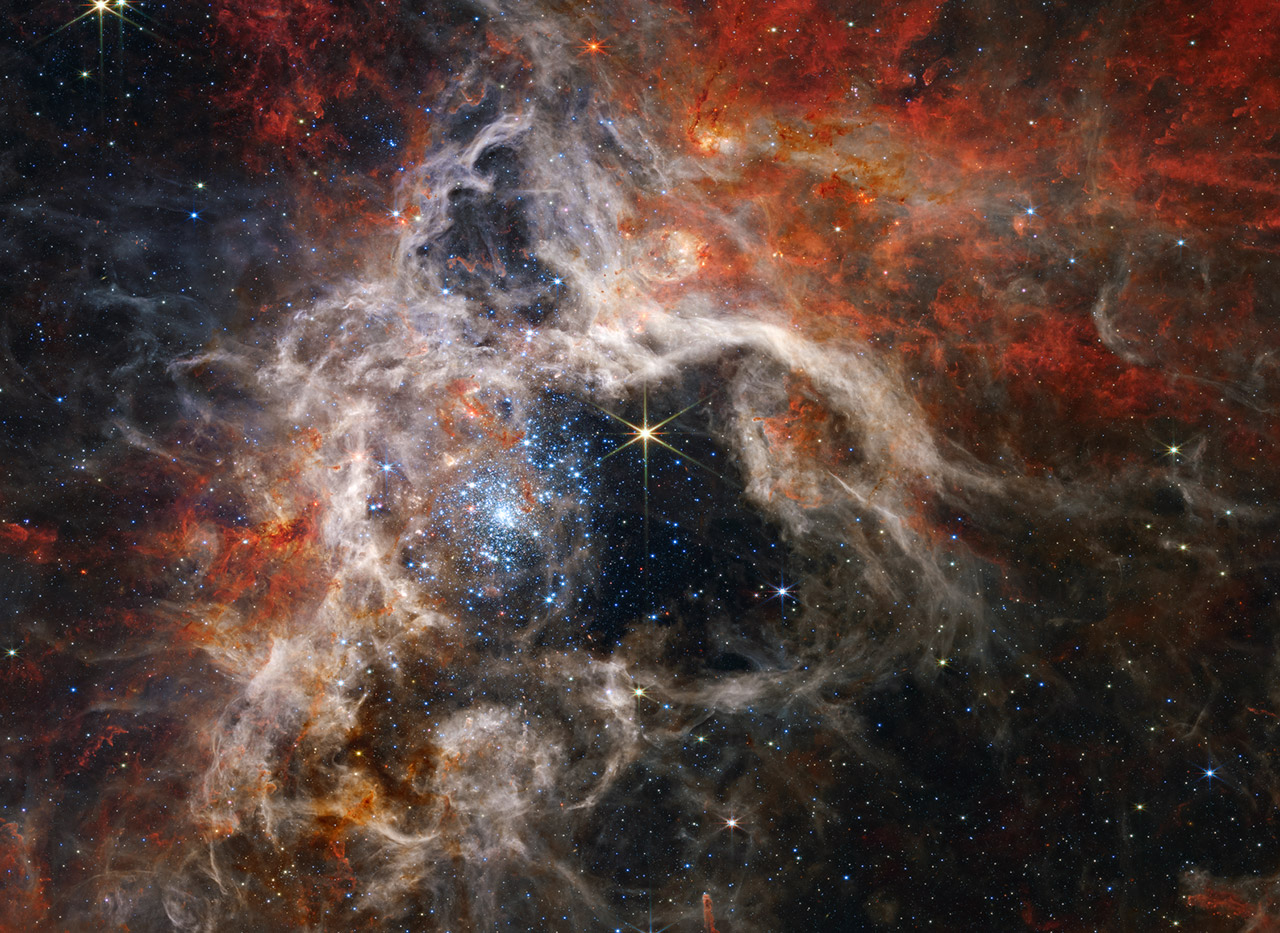Is there a celestial marvel, a cosmic factory, that dwarfs even the most vibrant star-forming regions we know? The Tarantula Nebula, also known as 30 Doradus, is not merely a star-forming region; it's the largest and brightest in the Local Group of galaxies, a cosmic powerhouse that outshines even our own Milky Way's stellar nurseries.
Nestled in the Large Magellanic Cloud, a satellite galaxy of the Milky Way, the Tarantula Nebula presents a breathtaking vista of stellar creation. It is a region teeming with young, massive stars, some of the most luminous and energetic objects in the universe. The nebula itself is a vast cloud of gas and dust, illuminated and sculpted by the intense radiation and stellar winds from these newborn behemoths. The very name, "Tarantula," hints at its appearance, with tendrils of gas and dust radiating outwards, resembling the legs of a spider. This cosmic spider web is a dynamic environment, where stars are born, live their brilliant but fleeting lives, and ultimately meet their explosive ends.
The Tarantula Nebula is more than just a pretty picture; it's a laboratory for astronomers, a place where they can study the processes of star formation in unprecedented detail. The nebula's proximity to Earth, compared to other star-forming regions, makes it an ideal target for telescopes like the Hubble Space Telescope, which has captured stunning images of its intricate structures and vibrant colors. These images reveal the delicate balance between stellar birth and destruction, a cosmic dance that continues to captivate and challenge our understanding of the universe.
- Best Remoteiot Platform For Raspberry Pi Your Ultimate Guide
- Setting Up Remoteiot Vpc Ssh On Raspberry Pi For Free A Comprehensive Guide
Within this stellar cradle lies R136, a super star cluster that contains some of the most massive and luminous stars known. These behemoths, far exceeding the mass of our Sun, are responsible for much of the nebula's brilliance and activity. Their intense radiation and stellar winds carve out cavities and shape the nebula's complex morphology, creating a dynamic and ever-changing landscape. The study of R136 and the surrounding nebula is crucial for understanding the evolution of massive stars and the impact they have on their environment.
The NASA/ESA Hubble Space Telescope has provided us with invaluable insights into the Tarantula Nebula. Its images, with their incredible detail and clarity, allow us to observe the nebula's structure, composition, and star formation processes. The data collected by Hubble, along with observations from other telescopes, helps astronomers to refine their models of star formation and to understand how these processes vary in different environments. This knowledge is essential for understanding the evolution of galaxies and the formation of the elements that make up everything around us.
Beyond the visual splendor, the Tarantula Nebula is a window into the early universe. The conditions within the nebula, including the high rate of star formation and the abundance of heavy elements, are thought to resemble those that existed in the early universe. By studying the Tarantula Nebula, we can gain insights into the processes that shaped the cosmos and the formation of the first stars and galaxies. It is a reminder that we are all, in a sense, made of stardust, and that the universe continues to reveal its secrets to those who look closely enough.
- Gorecenter The Ultimate Guide To Understanding And Exploring The Gorecenter
- Best Remote Access Iot Device Ssh A Comprehensive Guide To Secure Connections
The Tarantula Nebulas location within the Large Magellanic Cloud (LMC) is a significant advantage for astronomers. The LMC, being a satellite galaxy to the Milky Way, is relatively close to us, making it easier to study in detail compared to galaxies that are much farther away. This proximity allows us to observe individual stars, gas clouds, and other features within the nebula with greater precision. The LMCs lower metallicity (the abundance of elements heavier than hydrogen and helium) compared to the Milky Way provides an interesting contrast for studying star formation. This difference helps scientists understand how star formation is affected by the composition of the interstellar medium.
The study of the Tarantula Nebula continues to evolve with advancements in observational technology. The James Webb Space Telescope (JWST), with its ability to see in infrared wavelengths, is providing even deeper insights into the nebula. JWST can peer through the dust clouds that obscure our view, revealing the secrets of star formation in unprecedented detail. This new generation of telescopes is helping us to better understand the life cycle of stars and the evolution of galaxies, pushing the boundaries of our cosmic knowledge.
- Remotely Access Raspberry Pi A Comprehensive Guide To Remoteiot Download Free Windows
- Management Of Raspberry Pis Remotely With Remote Iot Management Platform


